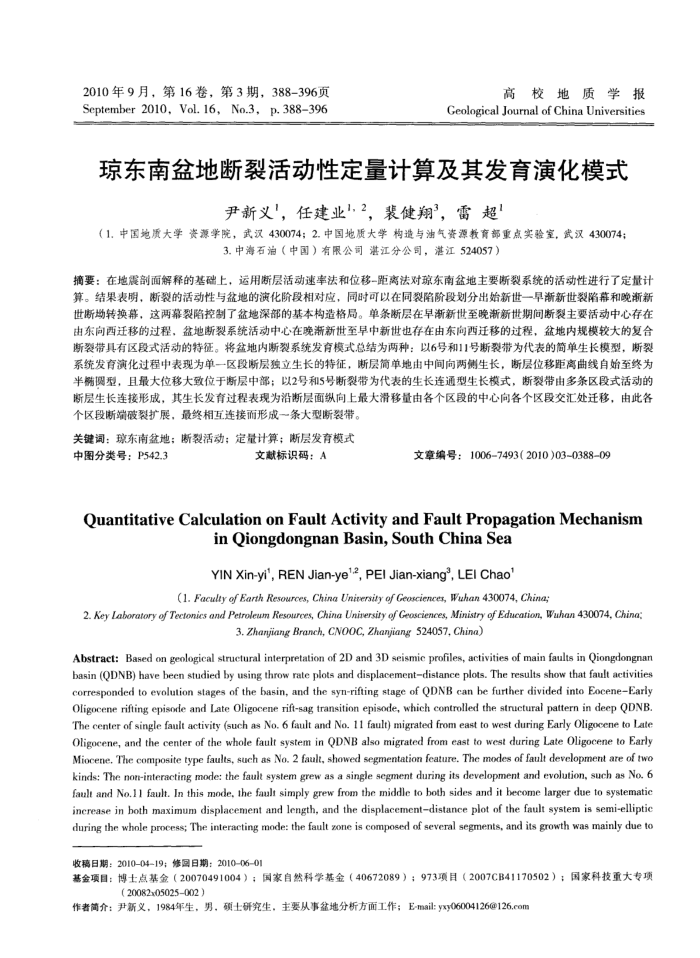琼东南盆地断裂活动性定量计算及其发育演化模式
内容简介
 2010年9月,第16卷,第3期,388-396页 September 2010,Vol.16,No.3,p.388396
2010年9月,第16卷,第3期,388-396页 September 2010,Vol.16,No.3,p.388396高校地质学报
Geological Journal of China Universities
琼东南盆地断裂活动性定量计算及其发育演化模式
尹新义",任建业",2,裴健翔3,雷超"
(1.中国地质大学资源学院,武汉430074;2.中国地质大学构造与油气资源教育部重点实验室,武汉430074:
3.中海石油(中国)有限公司湛江分公司,湛江524057)
摘要:在地震剖面解释的基础上,运用断层活动速率法和位移-距离法对琼东南盆地主要断裂系统的活动性进行了定量计算。结果表明,断裂的活动性与盆地的演化阶段相对应,同时可以在同裂陷阶段刘分出始新世一早渐新世裂陷幕和晚渐新世断勘转换幕,这两幕裂陷控制了盆地深部的基本构造格局。单条断层在早渐新世至晚渐新世期间断裂主要活动中心存在由东向西迁移的过程,盆地断裂系统活动中心在晚渐新世至早中新世也存在由东向西迁移的过程,盆地内规模较大的复合斯裂带具有区段式活动的特征。将盆地内断裂系统发育模式总结为两种:以6号和11号断裂带为代表的简单生长模型,断裂系统发育演化过程中表现为单一区段断层独立生长的特征,断层简单地由中间向两侧生长,断层位移距离曲线自始至终为半椭圆型,且最大位移大致位于断层中部;以2号和5号断裂带为代表的生长连通型生长模式,断裂带由多条区段式活动的断层生长连接形成,其生长发育过程表现为沿断层面纵向上最大滑移量由各个区段的中心向各个区段交汇处迁移,由此各
个区段断端破裂扩展,最终相互连接而形成一条大型断裂带。关键词:琼东南盆地;断裂活动;定量计算;断层发育模式
中图分类号:P542.3
文献标识码:A
文章编号:10067493(2010)03-038809
QuantitativeCalculationonFaultActivityandFaultPropagationMechanism
inQiongdongnanBasin,SouthChinaSea YIN Xin-yi', REN Jian-ye'-2, PEI Jian-xiang', LEI Chao
(1. Facully of Earth Resources, Ching University of Geosciences, Wuhan 430074, China,
2. Key Laboratory of Tectonics and Petroleum Resources, China Uninersity of Geosciences, Ministry of Educartion, Wuhan 430074, China
3. Zhanjiang Branch, CNOOC, Zhanjiang 524057, China)
Abstract: Based on geological structural interpretation of 2D and 3D seismic profiles, activities of main faults in Qiongdongnan basin (QDNB) have been studied by using throw rate plots and displacementdistance plots. The results show that fault activities corresponded to evolution stages of the basin, and the syn-rifting stage of QDNB can be further divided into EoceneEarly Oligocene rifing episode and Late Oligocene rifi-sag transition episode, which controlled the stnuctural pattern in deep QDNB. The center of single fault activity (such as No. 6 fault and No. 11 fault) migrated from east to west during Early Oligocene to Late Oligocene, and the center of the whole fault system in QDNB also migrated from east to west during Late Oligocene to Early Miocene, The composite type faults, such as No. 2 fault, showed segmentation feature, The modes of fault development are of two kinds: The non-interacting mode: the fault system grew as a single segment during its development and evolution, such as No, 6 ageasks o anp anae aoaaq pue saprs roq or appr a oy mara ds sne a apo s un y r'on pue ne inerease in both maximum displacement and length, and the displacementdistance plot of the fault system is semi-elliptic during the whole process; The interacting mode: the fault zone is composed of several segments, and its growth was mainly due to
收稿日期:201004-19;修国日期:20100601
基金项目:博士点基金(20070491004);国家自然科学基金(40672089);973项目(2007CB41170502);国家科技重大专项
(20082x05025002)
作者简介:尹新义,1984年生,男,硕士研究生,主要从事盆地分析方面工作;E-mail:yxy06004126@126.com